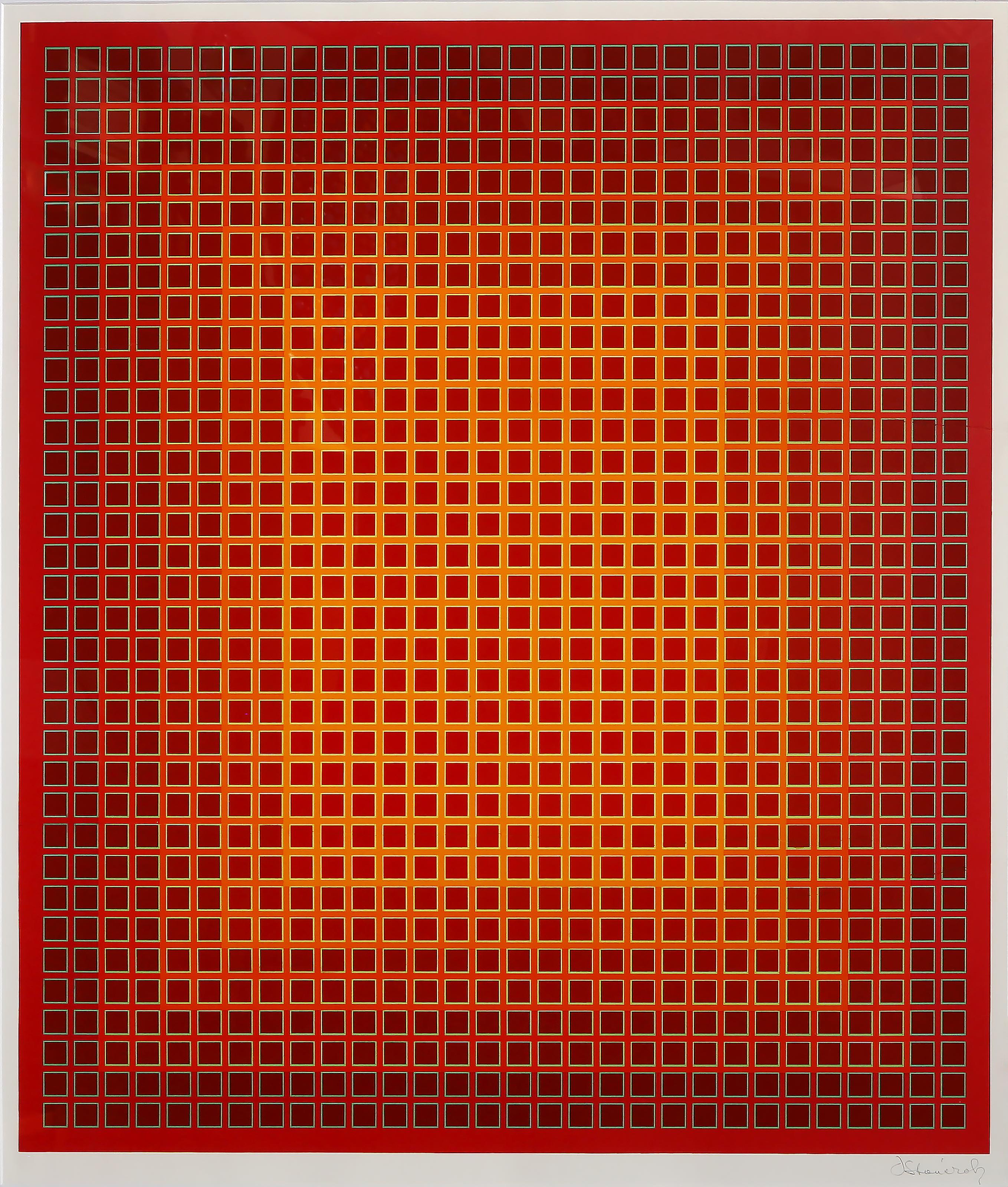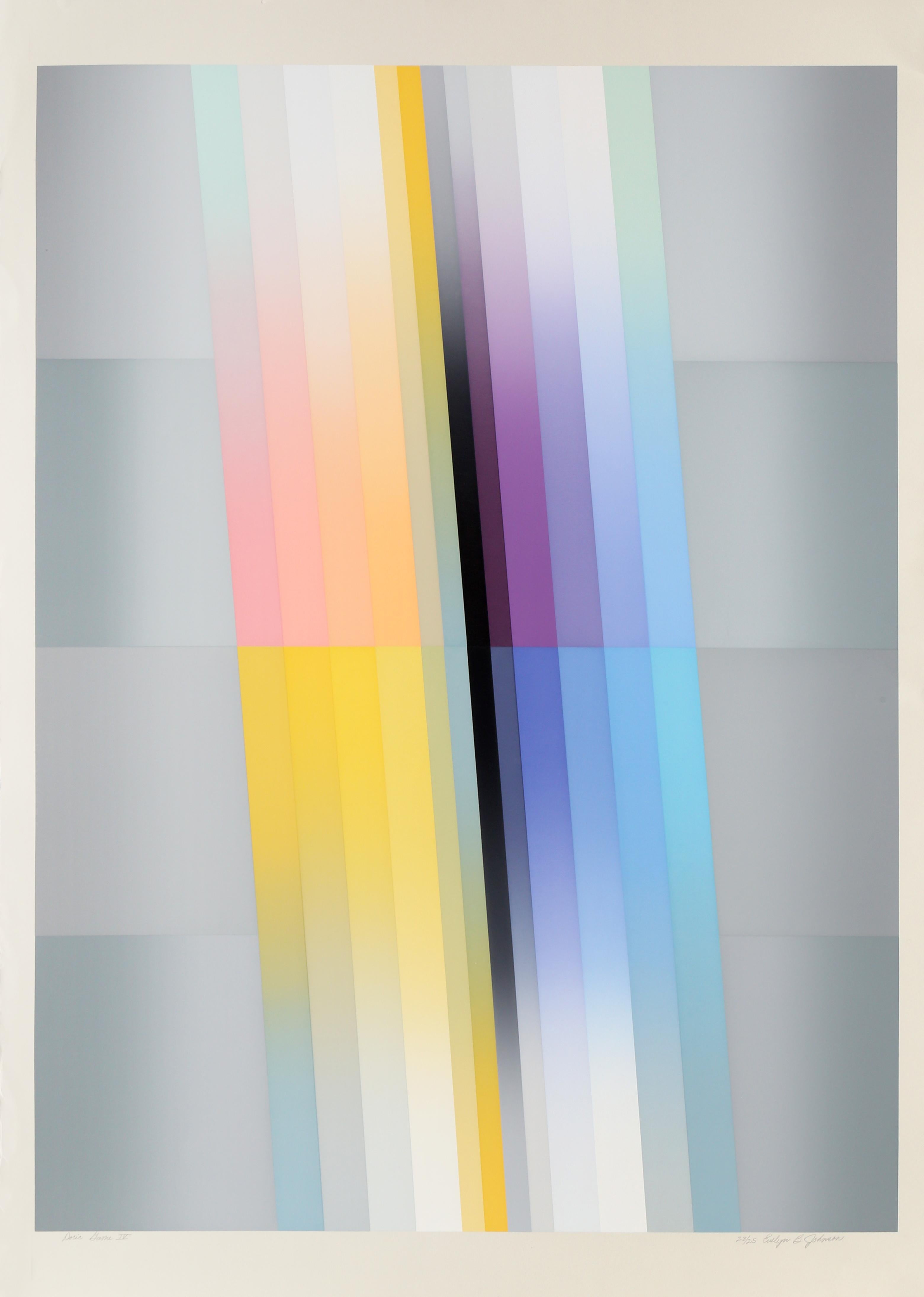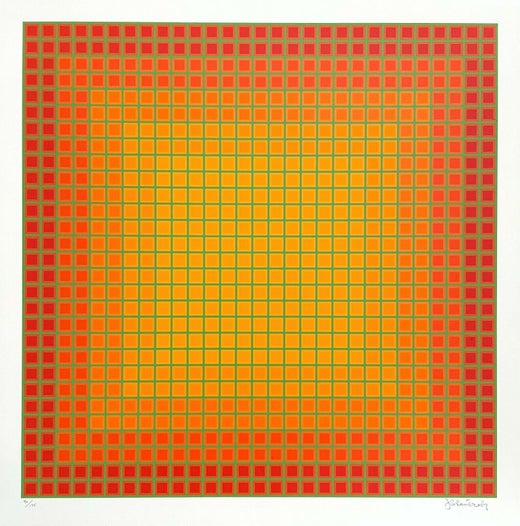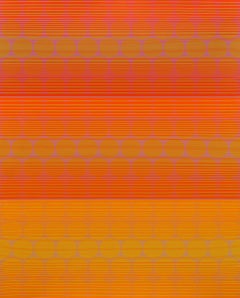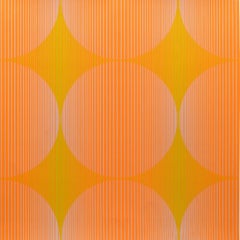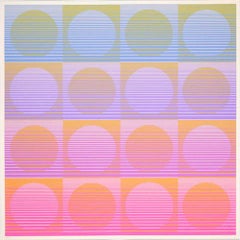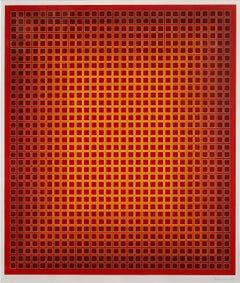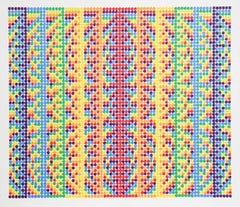Items Similar to Tempo of Three 1981 Screenprint 26 x 39 1/4 in. Edition of 175
Want more images or videos?
Request additional images or videos from the seller
1 of 8
Julian StanczakTempo of Three 1981 Screenprint 26 x 39 1/4 in. Edition of 1751981
1981
$8,100
£6,166.13
€7,049.19
CA$11,396.81
A$12,466.23
CHF 6,563.81
MX$148,834.15
NOK 83,656.73
SEK 76,525.95
DKK 52,650.21
About the Item
Technical Information:
Julian Stanczak
Tempo of Three
1981
Screenprint
26 x 39 1/4 in.
Edition of 175
Pencil signed and numbered
Accompanied with COA by Gregg Shienbaum Fine Art
- Creator:Julian Stanczak (1928, American)
- Creation Year:1981
- Dimensions:Height: 26 in (66.04 cm)Width: 39.25 in (99.7 cm)
- Medium:
- Movement & Style:
- Period:
- Condition:
- Gallery Location:Miami, FL
- Reference Number:1stDibs: LU53839780892
Julian Stanczak
Julian Stanczak was born in Borownica, Poland in 1928. At the beginning of World War II, Stanczak was forced into a Siberian labor camp, where he permanently lost the use of his right arm. He had been right-handed. In 1942, aged thirteen, Stanczak escaped from Siberia to join the Anders' Army in Persia. After deserting from the army, he spent his teenage years in a hut in a Polish refugee camp in Uganda. In Africa, Stanczak learned to write and paint left-handed. He then spent some years in London, before moving to the United States in 1950. He settled in Cleveland, Ohio. He became a United States citizen in 1957, taught at the Cincinnati Academy of Art for 7 years. The Op Art movement was named after his first major show, Julian Stanczak: Optical Paintings, held at the Martha Jackson Gallery in New York in 1964. His work was included in the Museum of Modern Art's 1965 exhibition The Responsive Eye. In 1966 he was named a "New Talent" by Art in America magazine. In the early 1960s he began to make the surface plane of the painting vibrate through his use of wavy lines and contrasting colors in works such as Provocative Current (1965). These paintings gave way to more complex compositions constructed with geometric rigidity yet softened with varying degrees of color transparency such as Netted Green (1972). In addition to being an artist, Stanczak was also a teacher, having worked at the Art Academy of Cincinnati from 1957–64 and as Professor of Painting, at the Cleveland Institute of Art, 1964-1995. He was named "Outstanding American Educator" by the Educators of America in 1970. (Wikipedia)
About the Seller
5.0
Recognized Seller
These prestigious sellers are industry leaders and represent the highest echelon for item quality and design.
1stDibs seller since 2017
58 sales on 1stDibs
Typical response time: 5 hours
- ShippingRetrieving quote...Shipping from: Miami, FL
- Return Policy
More From This Seller
View AllThree to Compare, from Twelve Progressions
By Julian Stanczak
Located in Miami, FL
TECHNICAL INFORMATION:
Julian Stanczak
Three to Compare, from Twelve Progressions
1971
Screenprint
31 3/4 x 26 in.
Edition of 90
Pencil signed and numbered
Accompanied with COA by ...
Category
1970s Op Art Abstract Prints
Materials
Screen
Fractions, from Twelve Progressions
By Julian Stanczak
Located in Miami, FL
Technical Information:
Julian Stanczak
Fractions, from Twelve Progressions
1971
Screenprint
26 1/2 x 26 1/2 in.
Edition of 90
Pencil signed and numbered
Accompanied with COA by Gre...
Category
1970s Op Art Abstract Prints
Materials
Screen
Aerial, from Twelve Progressions
By Julian Stanczak
Located in Miami, FL
Julian Stanczak
Aerial, from Twelve Progressions
1971
Screenprint
26 1/2 x 26 1/2 in.
EA #3
Pencil signed and numbered
Julian Stanczak (Polish, November 5, 1928 – March 25, 2017) was a Polish-born American painter and printmaker who is considered a central figure of the Op art movement in the U.S. during the 1960s and 1970s. Described as an artist whose work "evinced a tremendous geometric inventiveness", Stanczak is primarily known for his large-scale polychromatic abstract compositions made using acrylic paint on canvas in which he explored the perceptual dimensions of color.[3]
Born in 1928 in Borownica, Poland, Stanczak survived a Siberian labor camp during World War II where he lost the use of his right arm. He retrained himself to paint left-handed and emigrated to the United States in 1950, where he eventually became a citizen. In 1956, Stanczak received an M.F.A. from Yale University, where he studied with Josef Albers and Conrad Marca-Relli, and was roommates with fellow abstract painter Richard Anuszkiewicz. The term "Op art", since used to describe a short-lived movement of 1960s and 1970s, originated from Stanczak's work when the Minimalist artist and sculptor Donald Judd used it in his critical review of the 1964 exhibition titled Julian Stanczak: Optical Paintings at Martha Jackson Gallery in New York. Stanczak achieved broader commercial recognition after being featured in the landmark 1965 exhibition The Responsive Eye created by curator William C. Seitz at the Museum of Modern Art in New York.
As the popularity of Op art diminished in the late 1970s, Stanczak remained active as a painter and continued to exhibit his work, but became progressively separated from mainstream contemporary art in the U.S. In addition to being a practicing artist, Stanczak served as a faculty member at the Art Academy of Cincinnati from 1957 to 1964 and, later, as Professor of Painting at the Cleveland Institute of Art from 1964 to 1995. In 2013, he was awarded an honorary doctorate from Case Western Reserve University in Ohio. Stanczak lived and worked in Seven Hills, Ohio with his wife, the sculptor Barbara...
Category
1970s Op Art Abstract Prints
Materials
Screen
Median with Circles, from Variants 1970 Screenprint 28 3/4 x 28 3/4 in. Edit
By Julian Stanczak
Located in Miami, FL
Technical Information:
Julian Stanczak
Median with Circles, from Variants
1970
Screenprint
28 3/4 x 28 3/4 in.
Edition of 125
Pencil signed and numbered
Accompanied with COA by Gre...
Category
1970s Op Art Abstract Prints
Materials
Screen
Dedicated, from Twelve Progressions
By Julian Stanczak
Located in Miami, FL
TECHNICAL INFORMATION:
Julian Stanczak
Dedicated, from Twelve Progressions
1971
26 1/8 x 31 3/4 in.
Edition of 90
Pencil Signed and Numbered
Accompanied with COA by Gregg Shienbaum...
Category
1970s Op Art Abstract Prints
Materials
Screen
Centered Rings, from Twelve Progressions
By Julian Stanczak
Located in Miami, FL
Technical Information:
Julian Stanczak
Centered Rings, from Twelve Progressions
1971
Screenprint
26 1/8 x 31 3/4 in.
Edition of 90
Pencil signed and numbered
Accompanied with COA b...
Category
1970s Op Art Abstract Prints
Materials
Screen
You May Also Like
Sequential Chroma, Op Art Screenprint by Julian Stanczak
By Julian Stanczak
Located in Long Island City, NY
A colorful OP Art silkscreen by Poland-born American OP Artist, Julian Stanczak.
Artist: Julian Stanczak, American (1928 - 2017)
Title: Sequential Chroma
Year: 1981
Medium: Screen...
Category
1980s Op Art Abstract Prints
Materials
Screen
Untitled 14, Abstract Geometric OP Art Screenprint by David Roth
By David Roth
Located in Long Island City, NY
This screenprint was created by American artist David Roth. Roth's images are proportioned according to a strict mathematical formula - the pictures are composed according to horizon...
Category
1970s Op Art Abstract Prints
Materials
Screen
Op Art, Kinetic 1970s Original Vintage Silkscreen Lithograph Print
By David Roth
Located in Surfside, FL
Hand signed and numbered limited edition print.
David Roth studied at the Illinois Institute of Technology's Institute of Design and was twice the recipient of the Moholy-Nagy Scholarship in visual design. It was Roth's initial work as a designer at fine art for commercial use that brought him interesting positions as art director for Lanvin, Charles at the Ritz, and Germain Monteil.
. The strings are tied in bunches and closely hung tram a wooden bar. The size and shape of the string is similar to that at a canvas painting. Each bundle is represented by a vertical row at squares on the graph and the groupings at string are lined up along the wall according to the horizontal rows at the program. The six primary and secondary colors are used in their full intensity along with black, grey, and white.
As a painter Roth works to formulate with color. Some painters regard color as a concomitant of form, hence a subordinate, but Roth's color is the chief medium of his pictorial language. A programmed juxtaposition at primary color allows Roth and the viewer to play upon various combinations. The graphs Roth executes are proportioned according to a strict mathematical formula - the pictures are
Composed according to horizontal and vertical divisions on the graph paper. The optical quality of color, deliberately sought, has its roots in the Bauhaus investigations of illusion, and thus has a direct relationship to the Op art produced in postwar Europe. Roth has arranged his hues so as to persuade the planes to separate from the ground on which they are planted, and float free in space. It is almost as if Roth is giving us a "readout" on his creative process. Although the graphs appear to vary in their use of color the same colors are used throughout, also the same amount of color. Roth's work illustrates the sophistication of the human eye-brain relationship that has developed and invites the viewer to participate in the evolution at visionary ideas.
One Man Shows
1966 The Gallery Upstairs, Buffalo, New York
1967 The Gallery Upstairs, Buffalo, New York
1969 The House of Graphics, New York
1969 Illinois Institute of Technology, Chicago, Illinois
1972 Robert Elkon Gallery, New York
1973 Robert Elkon Gallery, New York
1974 Robert Elkon Gallery, New York
1975 Michael Wyman Gallery, Chicago
1975 Robert Elkon Gallery, New York
1976 G.W. Einstein, New York
1976 Robert Elkon Gallery, New York
1977 Robert Elkon Gallery, New York
1977 G.W. Einstein, New York
1978 Sunne Savage Gallery, Boston, Massachusetts
1978 Robert Elkon Gallery, New York
1979 Nancy Roth Gallery, Katonah, New York
Group Exhibitions
1967 State University of New York, Buffalo
1970 Ronald Feldman Gallery
1970 The Everyman Gallery
1971 Robert Elkon Gallery, New York
1972 The Brooklyn Museum, New York
1972 The Newark Museum, New Jersey
1972 Art...
Category
1970s Op Art Abstract Prints
Materials
Screen
David Roth, Abstract Screenprint, 1979
By David Roth
Located in Long Island City, NY
This screenprint was created by American artist David Roth. Roth's images are proportioned according to a strict mathematical formula - the pictures are composed according to horizon...
Category
1970s Op Art Abstract Prints
Materials
Screen
Doric Game IV, Abstract Screenprint by Evelyn B. Johnson
By Evelyn B. Johnson
Located in Long Island City, NY
Evelyn B. Johnson was an American Optical artist. Her work specialized in striking geometric abstract forms in bright colors whose shading mimics the effects of neon lighting. These ...
Category
1980s Op Art Abstract Prints
Materials
Screen
Untitled 25, Abstract Op Art Screenprint by David Roth
By David Roth
Located in Long Island City, NY
This screenprint was created by American artist David Roth. Roth's images are proportioned according to a strict mathematical formula - the pictures are composed according to horizon...
Category
1970s Op Art Abstract Prints
Materials
Screen
More Ways To Browse
Latin America Sculpture
Lying Down Sculpture
Moroccan Woman
Naughty Art
New England Portraits
Paintings Of Knights
Pele Vintage
Roger Winter
Studio Brancusi
Taos Pueblo
The Seed Sower
Tom Blachford Midnight Modern
University Of St Andrews
Vintage Bell Telephones
Wayang Kulit
Yard Sculptures
Adam Baranello
Andrew Winter
